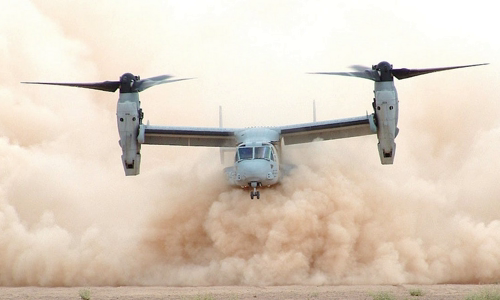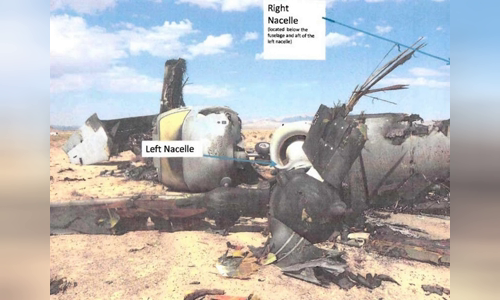The US V-22 hybrid helicopter has not been able to operate stably in the desert environment, despite efforts to improve the engine filter over the years.
The Pentagon Inspector General (OIG) in mid-November published a report on the difficulties the U.S. military faced with engine air-purifying devices (EAPS) on V-22 Osprey hybrid helicopters. This unit does not seem to be designed in accordance with specifications from engine manufacturer Roll-Royce to ensure that the Osprey line can operate stably in desert conditions.

The dust cloud was created by an MV-22 when it landed Photo: USMC
V-22 hybrid helicopters are primarily used for US marines and air force, but the navy is primarily responsible for the development process. The Office of the US Army Osprey Program is under the control of the Naval Air Systems Command (NAVAIR).
The problems with EAPS in particular and the engine in general have haunted the V-22, causing many fatal accidents in the past 10 years. The US Navy twice redesigned EAPS in 2010 and 2011, but both failed to address the division's faults. Experts fear a third attempt to fix the problem won't guarantee the Osprey line will work in desert environments.
"This redesign enhances the ability to filter dust from the V-22 engine's air inlet with the original EAPS model. The risks of operating V-22 have not been completely overcome, despite efforts to revise EAPS over the past 9 years, "the OIG report said.
The MV-22 variant of the marines and the CV-22 air force were in service in 2007 and 2009. Both models were powered by two Roll-Royce T406 engines. Each engine has an EAPS system to remove dust and foreign matter from the incoming air stream. The Japanese version of the V-22 and the upcoming CMV-22 variant of the US Navy also use the same design.
Osprey's two blades produce a great deal of thrust, making it possible for aircraft to take off vertically or on short runways like helicopters. However, they also blow dust and dust into the air and cover the entire aircraft when landing in the desert, reducing visibility and engine power, which can lead to the loss of lift that causes the aircraft to fall to the ground.
Stone pebbles and dust in the air stream also wear out, damaging turbine blades and engine walls. Alkaline metal sands can be melted by high temperatures in the engine, causing sensitive parts to stick and causing them to stop working.
Many accidents with the V-22 series originated from EAPS. An MV-22 crashed in Hawaii in May 2015, killing two marines and injuring 20. Investigators attributed the fault to the pilot, but also proposed developing a new air filter, while reducing the time it takes the helicopter to fly near the ground from 60 to 35 seconds.

An MV-22 dropped due to engine corrosion Photo: OIG
The US Navy discovered the problem of EAPS and began redesigning the unit in 2010. At that time, each V-22 was rated to operate 500 hours before having to change filters, but the sub The actual number when operating in the desert is only 200 hours.
Osprey hybrid helicopters 8 times had an abrupt loss of thrust between 2008-2015. Although these incidents did not lead to a plane crash, they still showed that the V-22's engine was quickly degraded. The U.S. Navy has to propose many measures to avoid this situation, including limiting the number of flight hours in a dusty environment, improving the system of loss of thrust warning and fixing the training curriculum.
Many of the proposed engine and EAPS modification projects later did not produce significant results. The OIG report said that the filter design projects failed because the test plan did not accurately reflect actual operating conditions.
"None of the soil samples in the test is suitable for natural conditions in the world. The Navy only tests EAPS with 100% sand or 100% mud, while the soil types in the world are made up mainly of sand, mud and clay, "the OIG report revealed.
The US Navy disagreed with OIG's conclusions, explaining that the air filter is strong enough at the manufacturer's request, causing the Osprey to lose its thrust when hovering near the ground because the engine does not draw enough air. .
In the latest revision, the US Navy decided to cooperate with the Special Operations Command (SOCOM) and the Air Force to redesign the engine air intakes with a product called "Innovative Intake Solution. "(IIS). However, this project is still incomplete and V-22 hybrid helicopters will have to continue to use EAPS in the near future.



 ElizabethCescarHallasgo
ElizabethCescarHallasgo







